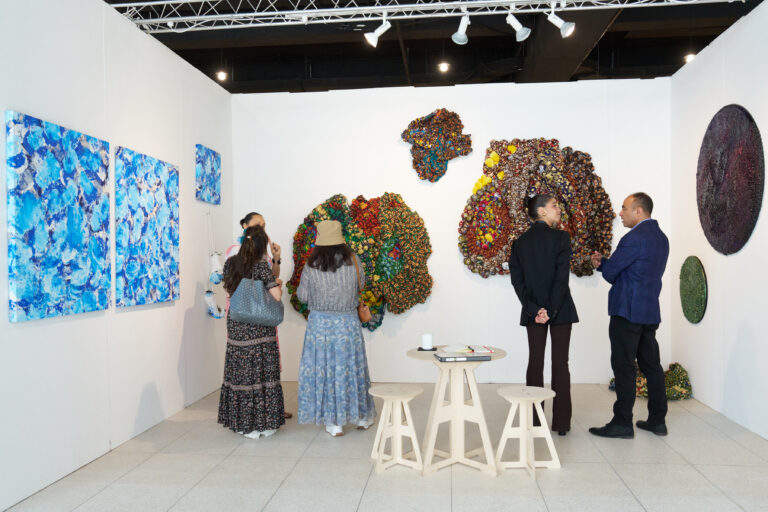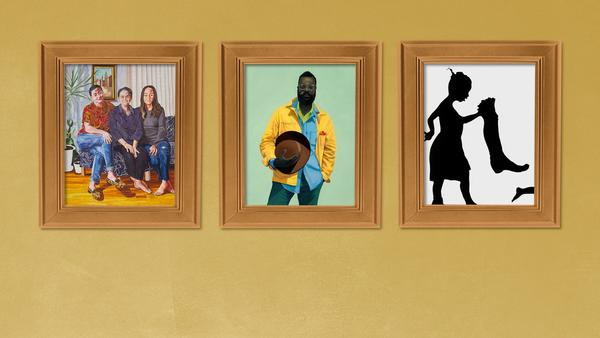The old St. Clair’s Cleaner building had one of the most iconic neighborhood murals in Miami. It was a seascape painting with mountain islands on the horizon in a soft blue sky. At the center, a fisherman harvesting the ocean on a tropical skiff with two beautiful portraits of women on each side of the wall as they smile off into the distance. The title once read “Welcome to Little Haiti,” later on “to Little Haiti” was redacted, painted over to blend into the sky. In the fall of 2015, the mural was painted over white. It was the artwork of Serge Toussaint.
Toussaint’s paintings can be seen on the façades of most commercial buildings in Little Haiti: bodegas, auto repair shops, botánicas, and restaurants. One merely drives along the neighborhood to experience how his work, interwoven within its structures, adds flavor to the community which has resided there for over forty years. Toussaint has been recognized as a muralist in Miami for decades, receiving awards and grants most notably the Florida Folk Heritage Award in 2016.
After experiencing the erasure of many of his murals representing Haitian culture, Toussaint was invited to create a new “Welcome to Little Haiti” mural on the white wall of artists owned building located at NE 2nd Avenue and 60th Street. Since the wall is only accessible through the adjacent vacant lot, the owner of the property was informed and granted Toussaint permission to enter the space to begin painting. After three weeks of work, the Haitian flag appeared, and the owner of the lot feared a loss of property value, access was revoked. The police were called for trespassing and threats of painting over the mural were made.
One of the building owners, Carolina Sardi, a sculptor, reached out to the lot owner to make the completion of the mural possible. His response, “if there was a Haitian Flag he could not sell this property.” He then promptly hung up the phone. Sardi’s husband, Jamie Piña, a filmmaker explained that Toussaint has been longtime friends with the lot owner and suspects the trespassing charges were the idea of Peter Ehrlich, who also owns property in the area. Peña stressed Ehrlich’s stance to keep all the walls east of northwest 2nd street white – certain to attract investment. “Peter Ehrlich is the Sheriff of Lemon City,” said Peña and is convinced the lot owner was persuaded to follow his business strategy.
Ehrlich is not the only property overseer to adopt a gentrification strategy within a developing urban area. The term “art washing” gained prominence in the Los Angeles neighborhood of Boyle Heights which is a predominately Mexican cultural community as an effort to speak to plans of gentrifying an economically challenged community as a “classic profit driven regenerative maneuver” by Feargus O’Sullivan of The Atlantic. In the case of the “Welcome to Little Haiti” mural, the strategy has been inverted with this group of artists collectively deciding to align themselves with the existing community. Ehrlich has no other option than to exercise the practice “white walling” for monetary gain. Hence, any form of alteration to the exterior of the structure and its environment can be seen as an act of vandalism, criminalizing art practice deemed undesirable. Law enforcement can be utilized to increase the presence of “broken windows” style arrests in Little Haiti which consistently happens in growing gentrified areas as new residence fail to integrate through economic restructuring leading to the criminalization of people of color. “Serge’s story is so indicative of the high tension, and huge tsunami of high-end development trying to pour in the community in addition to the racist tone Peter Ehrlich has set,” says Rachelle Salnave, filmmaker, and founder of Black Lounge Cinema, 2017 Knight Arts recipient. Anthony Spinello, curator, and founder of Spinello Projects came to the mural in the act of solidarity the day Toussaint requested a show of support. The Villain Theater, a space for preforming improve comedy artists negotiated with the building owner to keep an existing “Welcome to Little Haiti” mural intact. That painting celebrates important figures within the history of the neighborhood including portraits of Jan Mapou, Marlene Bastian, and Viter Juste who is credited with inspiring the community’s name.

Above: Anthony Spinello in front of Serge Toussant’s “Welcome to Little Haiti Mural”
The development model has shifted in Miami as opposed to Los Angeles where factions within the art community are taking an active turn to support longtime immigrant residence and regional culture in a lower economic class. As the city continues to grow with new massive development projects such as Eastside Ridge and Magic City’s attempt of rebranding the area as the Innovation District, one is left to speculate how this change will unfold into the future. Questions regarding which roles developers, businesses, new/existing residence, law enforcement, journalist, and artists will take on our local stage. In the meantime, Toussaint’s latest mural remains unfinished. There is ongoing research over the property line – the building owners believe that the delineating line ends four feet from the wall. If that is the case, Toussaint may be allowed to add another mural to his “Welcome to Little Haiti” series.












